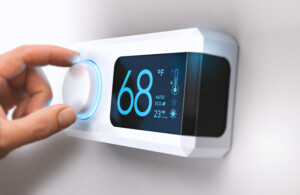As the weather turns and temperatures drop, managing energy costs becomes more of a challenge. With natural gas and electricity prices expected to rise this year, finding the most energy-efficient temperature setting is one of the simplest and most effective ways to control your heating bills. In this blog, we’ll answer the question “What is the best temperature for a heater in winter,” while also providing a few tips to help you save money as the snow and rain settle in across most of the U.S.
Best Thermostat Setting For Winter Months
According to the U.S. Department of Energy, there is no single recommended thermostat setting for residential and commercial buildings. Instead, homeowners and property managers should adjust indoor temperatures based on their schedules and activity levels.
When you’re home, the ideal temperature is normally 68-72 degrees Fahrenheit – warm enough for you to move about in seasonal clothing, such as sweaters and woolen socks. Trying to keep your home temperature above this range lengthens heating cycles, straining your HVAC system and driving up utility bills. Raising the temperature to the maximum possible setting often leads to heat fluctuations. It can also stir up dust and dander in your vents, lowering air quality.
Households with seniors and infants (who have a harder time regulating body temperature) are normally better off at the higher end of the above range. However, it’s estimated that decreasing the temperature one degree reduces heating costs by about three percent. So if you don’t mind snuggling under blankets, sticking to the lower end of the range is the best way to save money.
To maximize energy savings, lower temperatures to 59-64 degrees Fahrenheit at night or when you’re away from home. The cooler temperatures will help lower your energy bill, while still allowing for an easy warm up when needed. Be aware that temperatures below 64 degrees Fahrenheit can leave you vulnerable to health problems. They’re fine at night, when you’re bundled up safely in bed, but keeping them that low during the day may leave you susceptible to seasonal illnesses, such as the flu.
Other Tips To Help Save Energy
Besides adjusting room temperature, there are several other ways to lower your energy bills this time of year. These include:
- Regular Maintenance. Having your system inspected at the beginning of winter ensures it’s working properly and helps identify any potential weaknesses that could lead to a breakdown.
- Installing a Smart Thermostat. Smart thermostats automate your heating schedule, raising and lowering temperatures based on your habits and routine.
- Pulling Back Blinds and Curtains. Uncovering your windows lets in direct sunlight. The extra warmth reduces the number of heating cycles you have to run. However, keep in mind that this strategy is a double edged sword. Glass is a poor insulator. It lets in energy during the day, but lets it out at night, so always close blinds and windows after sunset.
- Weatherproof Your House. Drafts are a major source of heat loss. Even a small crack or gap around a door or window can upset your comfort level, allowing warm air to escape and cold air to seep in. Most drafts can be sealed with a layer of caulk. Under door drafts can be stopped with some weatherstripping.
When the time comes to upgrade your system, consider replacing your old furnace with an ENERGY STAR model. ENERGY STAR appliances are constructed to rigid standards for power and efficiency in order to provide considerable long-term savings.
Save on Home Repairs with Agway
In most homes, heating systems run almost continuously from winter until spring. When something goes wrong, it not only leaves your house freezing cold; it can also leave a gaping hole in your budget. Make sure you’re protected with Agway EnergyGuard™. EnergyGuard™ covers your heating, cooling, and electrical systems from wear and tear. Home insurance doesn’t pay for this type of breakdown, but we do.
When the need for repair occurs, our customers don’t waste time hunting around for a qualified repairman. They call us instead. Our service team maintains a network of HVAC contractors in your area and sends the first available one straight to your door. There are no service fees or deductibles either. We pay for the visit and all covered parts. Sign up today and start saving on home repairs with Agway EnergyGuard™.
